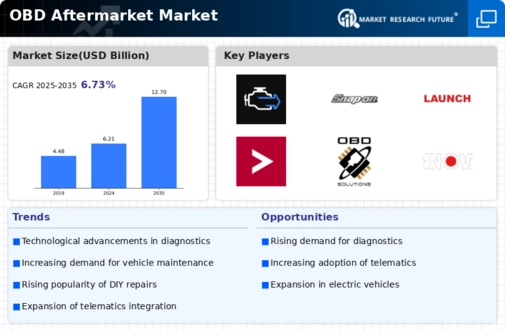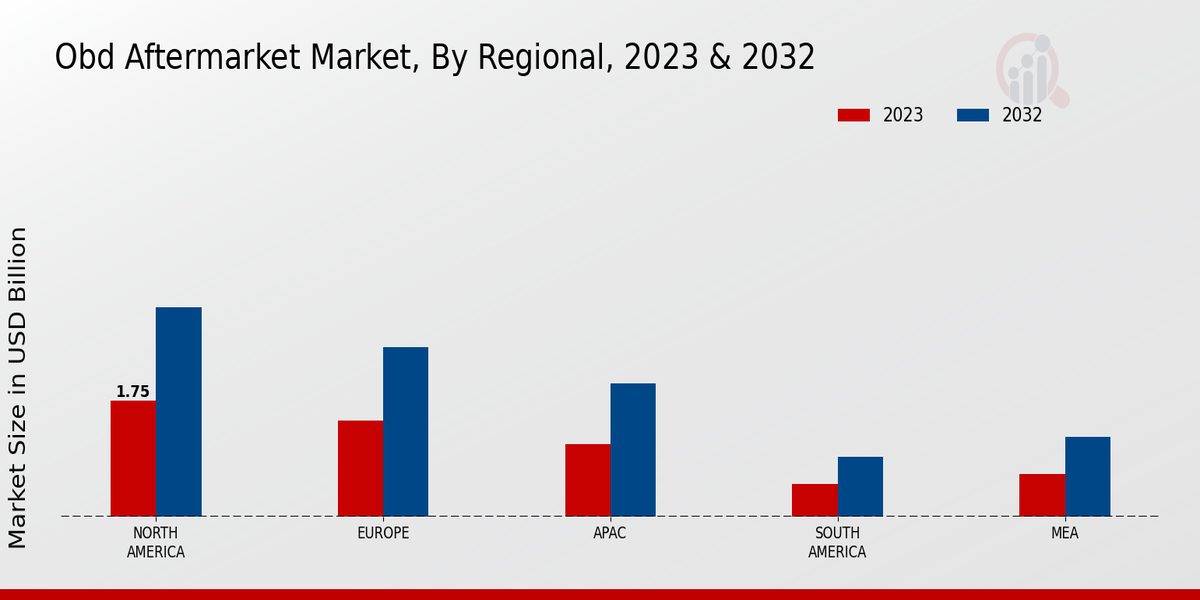Market Growth Projections
The Global OBD Aftermarket Market Industry is poised for substantial growth, with projections indicating a market size of 6.21 USD Billion in 2024 and an anticipated increase to 12.7 USD Billion by 2035. This growth trajectory suggests a compound annual growth rate of 6.74% from 2025 to 2035. Such figures underscore the expanding demand for OBD tools and services as vehicle technology evolves and regulatory requirements become more stringent. The market's expansion is indicative of broader trends in automotive diagnostics, reflecting the increasing complexity of vehicles and the corresponding need for advanced diagnostic solutions.
Increasing Vehicle Electrification
The ongoing trend of vehicle electrification is a pivotal driver for the Global OBD Aftermarket Market Industry. As electric vehicles (EVs) and hybrid vehicles gain traction, the need for specialized diagnostic tools tailored to these technologies becomes apparent. OBD systems in EVs require unique monitoring capabilities, which presents opportunities for aftermarket service providers. The projected growth in the EV sector is substantial, with estimates suggesting that the market could reach 12.7 USD Billion by 2035. This shift towards electrification is likely to reshape the diagnostic landscape, necessitating new tools and services to meet the demands of modern vehicles.
Expansion of E-commerce and Online Retailing
The expansion of e-commerce and online retailing is reshaping the Global OBD Aftermarket Market Industry. With the increasing prevalence of online shopping, consumers are more inclined to purchase OBD diagnostic tools and related services through digital platforms. This shift not only broadens the market reach for suppliers but also enhances consumer access to a variety of products. The convenience of online purchasing, coupled with competitive pricing, is likely to drive sales in the aftermarket sector. As a result, the market is expected to benefit from this trend, potentially leading to increased revenues and a more diverse product offering.
Regulatory Compliance and Emission Standards
Stringent regulatory compliance and evolving emission standards are significant drivers of the Global OBD Aftermarket Market Industry. Governments worldwide are implementing stricter regulations to reduce vehicle emissions and enhance air quality. This regulatory environment compels vehicle owners and service providers to invest in advanced OBD systems that ensure compliance with these standards. As a result, the demand for aftermarket diagnostic tools and services is expected to rise. The market is likely to witness a compound annual growth rate of 6.74% from 2025 to 2035, reflecting the urgency for compliance and the growing importance of effective emissions monitoring.
Rising Vehicle Ownership and Maintenance Culture
The increasing vehicle ownership rates globally contribute significantly to the Global OBD Aftermarket Market Industry. As more individuals acquire vehicles, the demand for maintenance and repair services rises correspondingly. This trend is particularly evident in emerging markets, where vehicle ownership is expanding rapidly. A growing maintenance culture among consumers, who are becoming more aware of the importance of regular vehicle diagnostics, further fuels this demand. The market's expansion is anticipated to align with the overall growth in vehicle numbers, thereby enhancing the need for OBD tools and services to ensure optimal vehicle performance and longevity.
Technological Advancements in Vehicle Diagnostics
The Global OBD Aftermarket Market Industry is experiencing a surge due to rapid technological advancements in vehicle diagnostics. Innovations such as advanced driver-assistance systems (ADAS) and enhanced onboard diagnostics are becoming increasingly prevalent. These technologies enable more precise monitoring of vehicle performance and emissions, thus driving demand for OBD tools and services. As vehicles become more complex, the need for sophisticated diagnostic equipment grows. This trend is expected to contribute significantly to the market, with projections indicating a market size of 6.21 USD Billion in 2024, reflecting the industry's adaptation to evolving automotive technologies.












